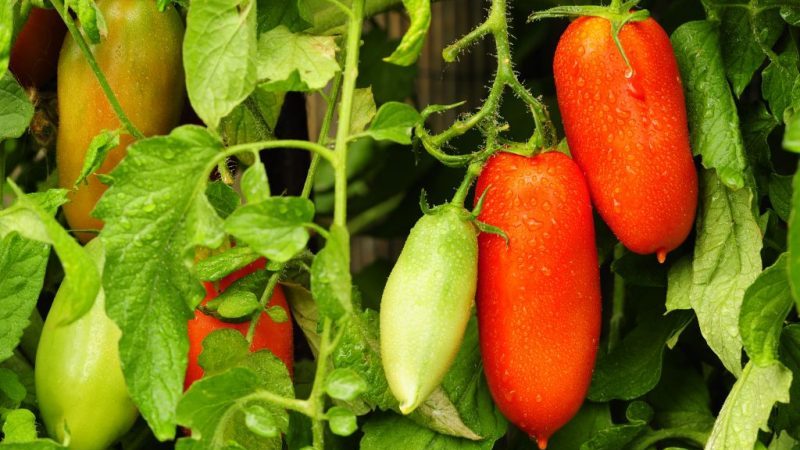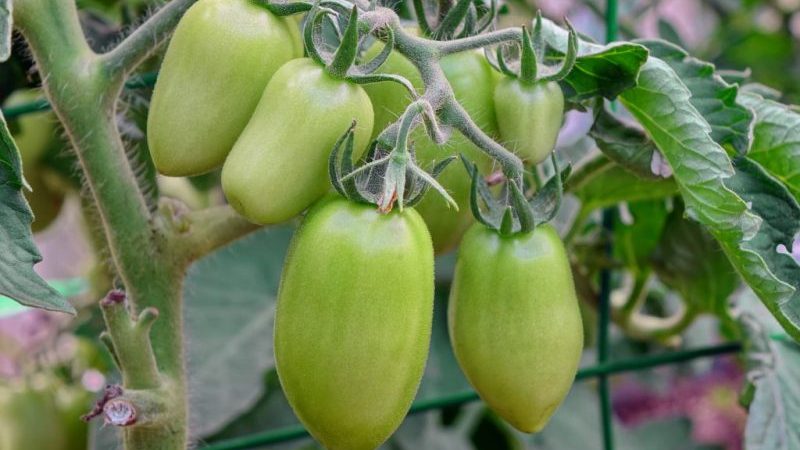A good choice for the fastidious summer resident - the Peter the Great tomato and the secrets of increasing its yield
Tomato Peter the Great is a hybrid characterized by high productivity and resistance to viral diseases, fungal infections. The culture was launched recently, in 2015, but is already enjoying success in the market. From this article you will learn all the features of growing tomato Peter the Great and the secrets of a good harvest.
The content of the article
Characteristics and description of the variety
Tomato Peter the Great belongs to the carpal hybrids and is intended for growing mainly in closed ground. Landing in open ground is possible only in mild climates, with a slight difference between day and night temperatures.
Plant indeterminate, has a powerful stem and great vigor. Without pinching the top, the height of the bush can exceed 2 m, and the number of carpal ovaries on it reaches 45 pieces.
The advantages of the Peter the Great variety:
- quick response to agrotechnical manipulations - fertilization, pruning;
- productivity - if the recommendations for care are followed, the yield reaches 10 kg per sq. m;
- universal use of fruits with excellent taste characteristics;
- long-term keeping quality of fruits, low losses during crop transportation.
The fruits of the Peter the Great hybrid are distinguished by an elongated pepper-like shape with a small nose. Average size - 10-12 cm, average weight 120 g. The skin and pulp of a ripe tomato have a bright red color, without light areas and spots. The structure of the pulp is dense, not watery, with a high percentage of dry matter. The taste is rich, sweetish.
How to grow seedlings
The cultivation of hybrid seedlings takes place according to standard rules, taking into account the specifics of the climate. The thoroughness of seed and soil treatment depends on the level of threat of infection with diseases and pests in a particular region of planting.
Seed preparation
Considering that 60-day seedlings should be transplanted into the greenhouse, and the best time for planting will be mid-May (for the middle lane), it is better to sow seeds for growing seedlings in the first half of March.
Hybrid seeds are usually already processed by the grower. But some gardeners still disinfect. Harmful microorganisms can live on the surface of seeds and become activated when they enter the ground. The simplest method of disinfection is soaking in hydrogen peroxide (3% solution) for 20 minutes.
Then the seeds are soaked in water at room temperature for 72 hours, wrapped in clean gauze. As a rule, on the third day, the sprouts are already hatching - the seeds are ready for planting.
Capacity and soil
Seed material is planted in boxes filled with universal store soil for tomatoes. There must be drain holes at the bottom of the boxes.
The land can be prepared independently by mixing peat, sand, and the top layer of garden soil in equal parts. It is recommended to additionally treat the soil with a weak solution of potassium permanganate and apply a small amount of organic fertilizers.
Sowing
The seeds are deepened into the ground by 1-2 cm, watered with warm water and create greenhouse conditions by covering the container with soil with a film. It is important that the soil in the box does not dry out or cool down. The best way to moisturize during this period is to spray the soil with a spray bottle.
The greenhouse must be well ventilated twice a day.If these conditions are met, seedlings appear on the 7-10th day.
Growing and care
After germination, Peter the Great's tomato seedlings need to provide good lighting, and in the second week - apply nitrogen fertilizers to stimulate growth.
When 2-3 leaves appear on the plants, they are dived from the common box into separate cups. The volume of the cups should be at least 0.5 liters so that the grown seedlings are comfortable.
How to grow tomatoes
Tomatoes require daily attention from gardeners. Following the recommendations for growing Peter the Great hybrid tomatoes will ensure healthy plants and a rich harvest.
Landing
The planting of Peter the Great tomatoes in greenhouses is carried out in mid-May - early June. By this time, nighttime temperatures in the greenhouse should not fall below 10 ° C.
Planting density per 1 sq. m is 3 bushes with the subsequent formation of 2 stems or 4 bushes when formed into 1 stem.
The soil in the greenhouse is prepared in the fall, replacing its top layer with soil from carrot beds. Then manure is brought in and the soil is dug up without breaking lumps.
Care

10 days after planting tomatoes in permanent soil, it is well loosened and organic fertilizers are applied. Mineral feeding added before flowering and during the period of fruit appearance.
Plants require abundant watering warm water - drying out of deep soil layers is unacceptable. Loosening of the soil is carried out weekly for a full oxygen exchange in the root system of tomatoes.
Bushes grow actively during the entire growing season, and it is recommended to harvest stepsons, pinch points of growth, crown.
Attention! During the period of fruit ripening, plants will need a solid support - wooden or plastic stakes of sufficient thickness.
Features of cultivation and possible difficulties
With responsible care, the Peter the Great tomato feels comfortable in greenhouse conditions and enters the fruiting period 110-120 days after germination. Sometimes, despite the observance of all agrotechnical nuances, there are difficulties with the ripening of fruits. To help the plant, experienced farmers advise to remove some of the tomatoes that have acquired an intermediate brown color.
Throughout the warm season, it is necessary to maintain an optimal humidity level in the greenhouse - this is ensured by regular watering of the soil and natural evaporation of moisture, but on dry summer days, you can install small containers of water between the bushes.
Diseases and pests
The Peter the Great hybrid is resistant to viral and fungal infections, but for prophylaxis it is recommended to periodically treat the ground part of the plant with Fitosporin.
When insects appearpests we recommend to spray the bushes with an insecticidal preparation. Root protection will be provided by watering with a solution of copper sulfate.
The nuances of growing in open ground and in a greenhouse
Tomato Peter the Great, like many mid-season hybrids, is not intended for growing outdoors. In the southern regions, it is possible to plant bushes outside greenhouses, in the beds, but in this case, you should take care of the possibility of quickly covering the tomatoes with a film from rain or hail.
Indoor cultivation is possible throughout Russia. At the same time, summer residents from areas located above the middle lane often use heated greenhouses. With proper care, tomatoes bear fruit until the end of September.
Regardless of the form of planting, Peter the Great's tomatoes require strong support, good lighting (at least 12 hours a day), and regular feeding.
Important! Plants must be protected from sudden temperature changes.
Harvesting and application of the crop
The ripening of the first Peter the Great tomatoes occurs at the end of June - July, the harvest ends in September. During this time, farmers manage to collect up to 10 kg of fruits from 1 sq. m greenhouses.
The variety is good for fresh consumption and for conservation.Taste and density make it possible to prepare sauces, juices, tomato paste from these tomatoes. If whole fruits are preserved, the strong skin does not break. The Peter the Great variety is perfect for drying.
Hybrid tomatoes tolerate transportation well and are stored for a long time, so surplus crops can always be sold profitably. After harvest, brown or green fruits are sent to ripen using the traditional method: they are laid out in wooden boxes in 2-3 layers, shifting with paper.
Advantages and disadvantages of the variety
The cultivation of tomatoes by Peter the Great does not require complex agrarian manipulations, and even inexperienced farmers can count on a good harvest.
The main advantages of the variety:
- prolonged fruiting;
- resistance to infections and fungi;
- pleasant taste and high density of fruits.
No obvious shortcomings in hybrids have yet been identified, in the list of possible inconveniences:
- the large size of the bushes, a tendency to grow rapidly;
- the need for a firm support, and not just tying up;
- difficult cultivation in the open field;
- it is required to partially unload the plant, removing unripe fruits.
To some gardeners, fresh Peter the Great tomatoes seem harsh for cutting into a salad. But this minus turns into a plus when canning.
Farmers reviews
The tomato variety Peter the Great was bred relatively recently and has not yet received sufficient distribution, but the reviews of the farmers who got acquainted with the hybrid are mostly positive.
Sergey, 48 years old, Novorossiysk: “High yields offset some of the inconvenience of growing. I have a large farm, and good keeping quality guarantees profit from harvest sales. "
Anna, 38 years old, Novgorod: “Summer in our region is not hot, so I plant tomatoes only in a greenhouse. Peter the Great has not let down for 3 years, but every year it is imperative to replace the fertile soil layer in the greenhouse. "
Irina, 42 years old, Saratov: “It's a pleasure to enter the greenhouse - the tomatoes have grown strong and healthy. Large clusters of ripe tomatoes look impressive, and it's nice to add their photos to the archive of my agricultural achievements. "
Conclusion
Tomatoes Peter the Great can be safely recommended for cultivation if there are sufficient greenhouses and the basic rules of care (regular watering, loosening, feeding) are observed. The hybrid is not too whimsical and will pay off with a bountiful harvest.